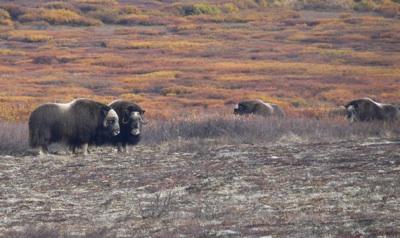Bad weather, lack of a presidential inauguration, and safety concerns along the Southwestern border with Mexico apparently were the major drivers behind a slight dip in 2010 visitation to the National Park System from 2009 levels.
Overall, 2010 visitation stood at 281.3 million, down from 285.6 million the year before, according to the National Park Service's statistics.
Much of the decline can be explained by ice storms that closed most of the Blue Ridge Parkway last January, February, and March, something that Park Service officials say contributed greatly to a 1.4 million decrease in 2010 visitation over 2009 levels; the presidential inauguration in January 2009, an event that swelled visits to the National Capitol Parks Central unit and President's Park by possibly more than 3 million over what otherwise might be expected; and border concerns that dropped Amisted National Recreation Area's 2010 visitor tallies by just short of 1 million, something Park Service officials attributed in part to professional fishing events going elsewhere.
Here are some tidbits gleaned from the just-released 2010 visitation numbers:
* Overall, 192 units of the National Park System saw visitation increases from 2009 to 2010, while 171 parks reported decreases.
* Visits to the 58 "national parks" in 2010 were up to 64.6 million, a 1.6 million increase from 2009. Leading the way were Yellowstone National Park, which reached a record 3.6 million visitors for the year, an increase of 344,998; Glacier National Park, which saw a 168,700 boost to a record 2.2 million visitors during its centennial year; Acadia National Park, which recorded 2.5 million, an increase of 276,510; and Yosemite National Park, up 163,936 to 3.9 million.
* Amistad NRA counted 2,573,966 visitors in 2009, but just 1,574,322 in 2010.
* At Ross Lake National Recreation Area, part of the North Cascades National Park Complex, a change in counting generated an increase of 394,278 visitors in 2010 over 2009 levels.
* The Chesapeake & Ohio Canal National Historical Park 2010 visitation was 4.1 million, a healthy boost of 359,577 from the year before.
* Without a presidential inauguration, visitor counts at the National Capital Parks Central unit dropped 2.3 million from 2009 to 2010, to a total of 1.36 million. At President's Park, 2010 visitation plunged to 616,635 visitors in 2010, a drop of 858,547 from 2009 levels.
* Visits to the Blue Ridge Parkway in 2010 totaled 14.5 million, down from 15.9 million in 2009.
* Visits jumped in 2010 at the Lincoln Memorial National Monument, up 786,745 in 2010 to 6 million.
* The Park Service had forecast a decrease of 1.5 million visitors in 2010 from 2009 levels. Take out the ice storms at Blue Ridge Parkway and they would have been pretty close to that estimate.
And here are some other statistical tidbits that might be interesting to no one other than me:
* Clara Barton National Historic Site more than doubled its visitation, going from 10,986 in 2009 to 23,741 last year.
* Steamtown National Historic Site cleared the 100,000 mark, reaching 104,855 visitors in 2010, an increase of 39,711 from 2009.
* Adams National Historical Park's visitation dropped by more than two-thirds in 2010, going to 73,339 from 253,656.
* Valley Forge National Historical Park greeted 168,283 more visitors in 2010 (1.6 million) than in 2009 (1.4 million).
* Three of the four national lakeshores saw increases in 2010, ranging from 51,066 more at Pictured Rocks (499,281) to 205,777 more at Indiana Dunes (2.1 million). Apostle Islands National Lakeshore saw visitation drop by 13,257 in 2010, to 156,945.
Part of the problem at Apostle Islands might have been linked to black bear activity, as Hermit Island was closed to all visitation through June, and to camping in July due to bears, and Manitou Island was closed to camping throughout August, September, October and November due to the bruins. Visitation also might have dropped at the lakeshore in February and March as the mainland ice caves were not accessible via the lake, according to officials.
* Organ Pipe Cactus National Monument saw visitation drop more than a third, from 330,064 in 2009 to 209,602 visitors last year, very possibly due to border concerns.
* 2010 must have been the year to head to distant national parks. In Alaska remote Kobuk Valley National Park, which requires an air taxi or parachute to reach, saw 3,164 visitors in 2010, not quite double the 1,879 who made the trek in 2009, but still a healthy increase. Bering Land Bridge National Preserve, which also has no roads leading to it, counted 2,642 visitors in 2010, more than double the 1,054 who showed up in 2009.
If you'd like to crunch the numbers yourself, you can find them at this site.




Comments
Adams NHP: I have no idea but here's a question: does it depend on school field trips? It's certainly imaginable that school districts would cut field trips in the current financial climate.
Southwest parks: I think Americans are taking more lengthy car vacations, instead of flying domestically or internationally. That's probably what's going on with the Yellowstone record attendance. So whatever's going on at Organ Pipe or Amisted is probably something else.
It's certainly easy to meet a Mexican who is illegally in the US when you're in Big Bend. I met day trippers who were just leaving crafts and picking up cash from the little cans they leave. I don't know if such encounters (and the Border Patrol checkpoints outside park) discourage visitors or not.
Maybe I missed it, but what criteria were used to determine visitation numbers?
The drop at Adams NHP is easy, the HBO series came out in the spring of 2008. They were immediately overwhelmed and had to add additional tours and staff. Then it dropped off.